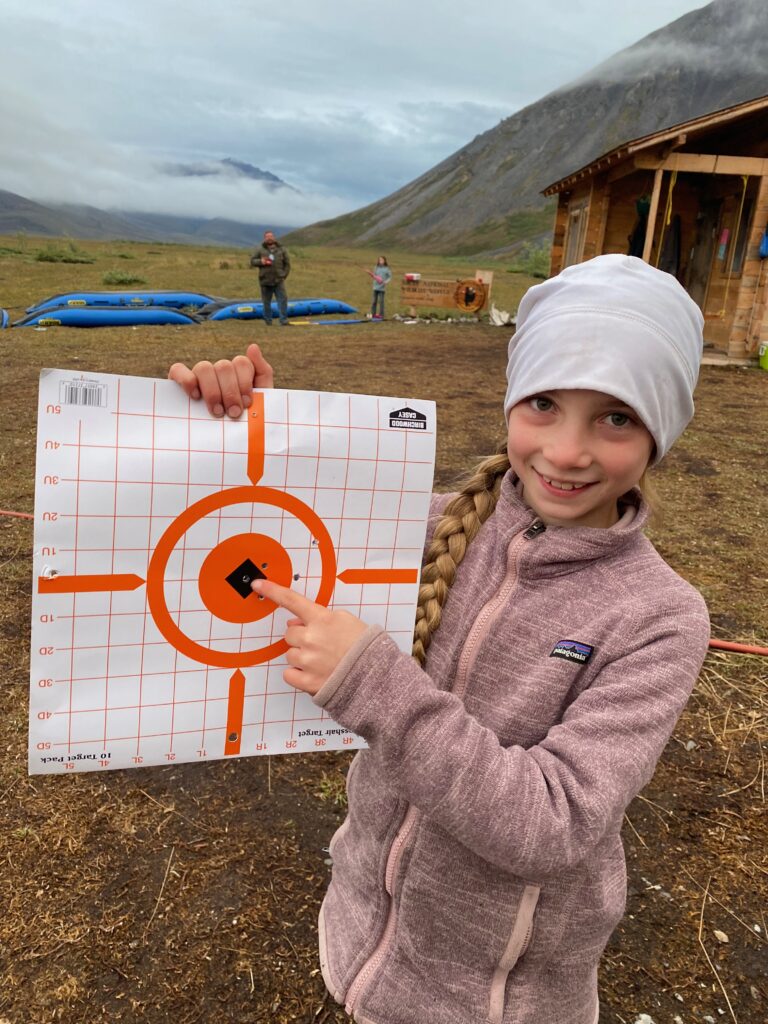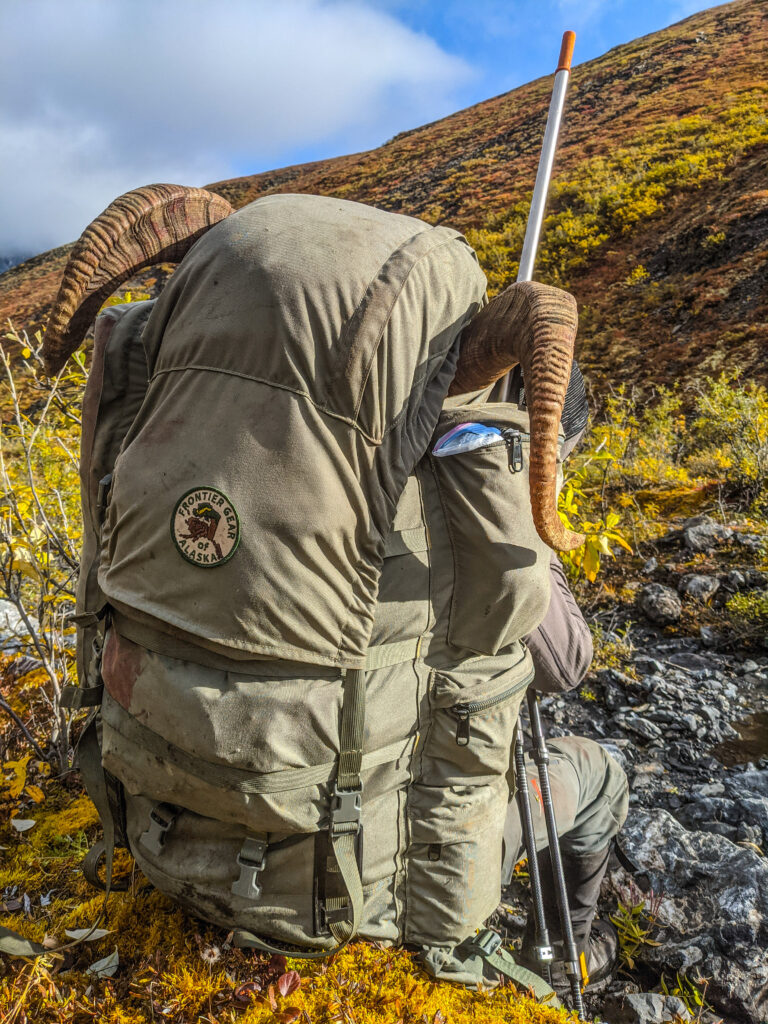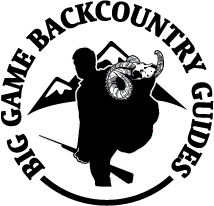Alaska is rugged and hard on equipment, and it is important to have good quality gear that is made to take the abuse of a mountain sheep hunt. Ounces turn into pounds and there is a lot of truth in the sheep hunter’s adage of “cut the handle off of your toothbrush to save an ounce”.
A sheep hunters’ goal is to have a pack under 50lbs with enough stuff to stay out in the mountains for 4 to 5 days before needing resupply.
Quality should take precedence over weight.
We recommended gear that will make your trip enjoyable and keep you comfortable while taking into consideration weight, cost, dry-ability, pack-ability, and overall quality. We are professionals hunting in a remote harsh environment and we depend on tools to get the job done safely. BGBG is passionate about gear. With proper gear, we can travel comfortably through the arctic for extended periods of time safely.
If you have any questions on gear as you prepare, please take the time to contact us. Sitting on the side of the mountain is not the place to be wishing you had brought something different.
Sportsmen who take their hunting seriously take their gear seriously.
We are not financially endorsed by any of the companies we list. We just want you to be well equipped to make your trip more pleasurable and as safe and comfortable as you can be in the remote Arctic.
Sportsmen who take their hunting seriously take their gear seriously.
We are not financially endorsed by any of the companies we list. We just want you to be well equipped to make your trip more pleasurable and as safe and comfortable as you can be in the remote Arctic.
We recommend you take a look at the gear and gear list found at Barney’s Sports Chalet:
For a printable gear list go to:
https://www.barneyssports.com/wp-content/uploads/2014/01CL-Guided-Sheep-goat-2013.pdf

Rifle
Above everything we recommend a gun you are familiar with, trust, and like. We recommend a scoped lightweight, Bolt Action Rifle that is stainless with a synthetic stock. The complete rifle with a scope should weigh less than 8lbs. If you are looking for a good excuse to go buy a custom sheep rifle, have fun and do your research. There are many custom gun makers out there. Your rifle should have a comfortable sling so you can have free hands to cross tough terrain.
For calibers I recommend a 300 caliber but a 270 is very sufficient. If you choose to hunt a grizzly you may consider a little more caliber like a .338. There are many wild cats out there and if this is your choice bring extra ammo due to availability and know your ballistics.
Scopes have come a long way lately with long-range turrets that allow you to shoot 1000 yards accurately. To be consistent at long range you need a high-quality barrel and an accurate range finder. Ranging can still be tough depending on terrain, lighting, and ground cover.
We recommend a Leupold vx5, vx6, or night force nx8 or something with a dial and a zero stop. We also suggest for you attend a shooting school. The cost is well worth it compared to missing a ram. Add it into a weekend vacation and bring your rifle.
Ammo
2 boxes of your pick that shoots well in your rifle that the communist party hasn’t taken off the shelf. There are a lot of choices in high-quality ammo out there and this comes down to what shoots well in your barrel.
Boots
Of all your gear your boots are your most important item. To keep healthy feet requires not just a boot but a system for your feet and the boot is one part of the system. The other parts of the system are insoles, socks, gaiters, and camp shoes. Your feet should have natural calluses left alone and trimmed nails. When selecting parts of this system go off of your personal history on other hunts. There is no need to experiment on a sheep hunt. If your feet easily get cold while hunting elk in Colorado adjust with warmer socks and installation.
Scarpa from Kuiu or Crispi Brikdale sf gtx
Camp Shoe
Something you would do a cross-fit workout in, go jogging or to the gym in. Nice light-weight breathable shoe. Keen, Merrill, or Reebok are great choices.
Wading Pants
Hip boots are optional. They are needed more on Caribou and Grizzly hunts where the creeks are larger and more river crossings.
Socks (4 pairs)
Darn Tuff or Smart Wool Socks.
Neoprene Socks (1 pair)
Neoprene socks are optional. When all else fails your boots are wet or you’re going to spend the day walking or floating down river Neoprene socks over a dry pair of wool or by themselves can be a lifesaver. My favorite is wet suit pants with built-in feet cut off below the knees.
Gaiters (1 pair)
Gaiters seal between your pants and boots keeping out unwanted water while crossing braided rivers and low wet vegetation with snow. We recommend Outdoor Research, Kenetrek, or Sitka gear storm front.

Backpack
A quality pack is almost as important as the boots you pick and should be around the same financial investment. The pack should be a large expedition-style pack that offers great support when loaded and be quite comfortable with 50 lbs. of gear. Your pack should be at least 6000 cubic inch allowing enough room to carry bulk lightweight gear; a sleeping pad, sleeping bag, clothes, food, and a one-man tent. One of the reasons you will need a bigger pack is when you shoot your sheep you will need to carry all of your personal gear and some of your guide’s personal gear that is light and bulky to free up room in his pack so he can carry the sheep off the mountain.
The question when looking for a pack is an internal frame or external frame packs. External frames offer great support with large bulky loads. There are some great internal frame packs out there and they are lighter and less bulky.
You cannot beat Barney’s pack from Barney’s Sport Chalet in Anchorage.
If you go to buy a custom pack load it up with weight to see how it feels (50 lbs). Most packs feel good less than 20 lbs. Wear it for some time and see how your shoulders feel and try to adjust the shoulders and waist belt to transfer weight between hips and back and shoulders.
Sleeping Bag
We recommend a lightweight, compressible, synthetic bag for 15F-20F. If you sleep cold and care coming in later August you might consider a colder rating. Your bag should weigh under 5 lbs. and be compressed in a small waterproof compression bag (E-Vent). BGBG uses a Mont bell spiral synthetic bag and Mountain Hardware. There are some awesome new pads out there on the market. The super lightweight ones are fragile and often leak and for this reason, we recommend having a patch kit.
Binoculars
High-quality binocular is well worth the investment and they will last a lifetime. I have and continue to use my 10×42 Leica for the last 12 years. BGBG recommends 10×40 Leica, Swarovski, and Zeiss. A binocular harness is optional but they are nice for comfort and a shield from the weather.
Rain Gear
Notice I have the rain gear separated from the normal clothes with the important gear. Your rain gear should be lightweight and packable. Your rain gear needs to be completely waterproof not weather resistant. This is your shell layer and shouldn’t be insulated and should be oversized to fit over other layers. BGBG recommends Kuiu Chugach jacket and pants or Helly Hanson Impertek. No insulated Gore-Tex coats.
Clothing
Your clothing will be worn in layers with rarely more than three layers worn at any one time. Each layer will increase in insulation and can be covered with a shell/waterproof layer. You should have one extra-base layer to wear while one base layer can dry. There will be one layer of insulation that is kept handy on top of your pack to put on while glassing. This is also your survival gear and should be kept dry and on you at all times.
Upper Body
Lower Body
Head & Hands
Miscellaneous
Trekking Poles
Two poles for even stability or one to keep a hand free for climbing. I recommend a carbon high quality pole such as Black Diamond carbon alloy or Alpine Carbon Cork.
Water Bottle
Nalgene wide mouths are easy to fill. They can be filled with hot water and have the lid screwed down tight to sleep with.
Camera w/extra battery life
Battery life is short in cold weather and it is well worth carrying an extra battery. I would recommend a small pelican case for your camera that is waterproof but a Ziploc will work.
Snacks
2-4 lbs of favorite snacks. Your favorite drink mix such as Wilderness Athlete or Mtn Ops or instant coffee are all great comforts to have with you. Do not bring a 2lbs jug of Mtn Ops drink mix, break it down into single servings with enough for each day. If you start out each day with a cup of coffee and a hydrate and recovery of wilderness athlete do not change it up on your hunt. Keep your routine. If you change it up too much you could end up with headaches, cravings, or shakes.
Pocket Knife
Hunting Knife
This knife should be lightweight. There is no reason to have more than one skinning knife. BGBG recommends a Piranha with surgical blades or Victornox paring knife.
Lightweight Dry Bags
Nice to keep clothes organized and dry. I recommend E-0vent or Sea to Summit. Also, plan to bring extra dry bags to carry your meat home in.
Book (1)
Nice for weather days or while waiting on planes. You can always trade with your guide if you finish your book early.
Extra Eyeglasses (contacts)
Medications
Bring extra medication if needed to allow for extra days due to weather. I also recommend brining extra Ibuprofen/Tylenol.
Drinks
If you like certain drinks for instance coffee/hot chocolate/tea/energy or alcohol. Small comforts go a long way in the field. Just don’t bring a heavy glass jug.
Cash
Extra cash for traveling, trophy fees, and guide gratuities.
Trip Insurance
Booked through SCI (Safari Club International) off of their webpage and will ensure your entire trip, plane tickets and all.
Tenacious tape
It is great to carry for patching everything but not essential.
Battery Packs
For charging cell phone/camera/InReach; Rav battery pack 32000mAh USB power Bank, Anker USB-C portable charger min 10000mAh
